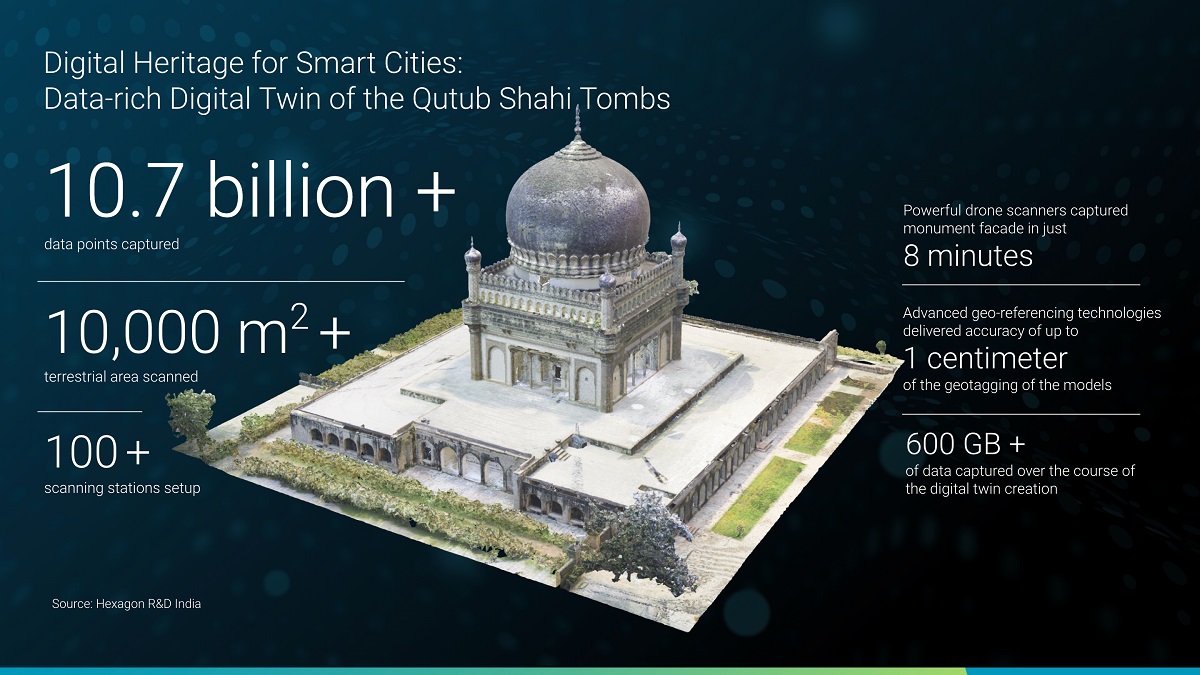
The restoration, preservation, and maintenance of heritage sites has increasingly devolved on the planners of the smart cities the world over, which house such sites. The Indian state of Telangana while aiming to make its capital, Hyderabad, a metropolis of the future also sees itself as a responsible custodian of its rich heritage.
To effectively fulfil this role the government is being assisted by the Sweden-headquartered Hexagon, a global leader in digital reality: an omnibus term that encompasses technologies like virtual reality (VR), augmented reality (AR), and geospatial systems to simulate real world systems or objects.
Engineers of the Hyderabad-based India R&D Centre of Hexagon, have just delivered a digital twin of the famed Qutub Shahi Tombs on the outskirts of the city, a cluster of tombs and mosques built by the Qutub Shahi dynasty in the 16th and17th centuries.
The complex is on UNESCO’s tentative list to be named a world heritage site – and arguably the visualization and real-time analytics provided by the digital twin, will facilitate conservation decision-making that will encourage the global body in naming the tombs a heritage site.
What is a digital twin? It is a digital replica of a physical product, system, or process that serves as an indistinguishable virtual counterpart for practical purposes. It spans the object's lifecycle and uses real-time data sent from sensors on the object to simulate its behaviour and monitor operations. This generates valuable insights—which can then be applied back to the original physical object.
Hexagon’s Hyderabad team deployed multiple software and hardware technologies, including 3D scanning, geospatial mapping, and reality capture to generate 10.7 billion data points for the creation of the digital representation of the tombs. The team utilized an autonomous flying drone equipped with a laser radar or LiDAR capable of capturing 2 million points per second. Engineers then applied advanced AI solutions to stitch together a data-rich actionable digital twin.
Handing over the digital twin to Jayesh Ranjan, Telangana state’s Principal Secretary, Industries & Commerce and Information Technology, Hexagon’s President and CEO Paolo Guglielmini, said: “The creation of this digital twin of the iconic Qutub Shahi Tombs is a step towards our vision of digitally safeguarding cultural heritage sites across the globe. Our work in Hyderabad demonstrates how forward-looking innovation and reality technologies can be used to protect our most valued connections to the past while advancing smart cities for our future.”
Navaneet Mishra, Senior Vice President and Head, Hexagon R&D India, added: "The Qutub Shahi Tombs Digital Twin project is a fully functional proof-of-concept of Hexagon’s Digital Heritage for Smart Cities, demonstrating how we can help preserve the rich heritage of our country. The data-richness of Hexagon’s digital reality will make it easy for governments, planners, and conservationists of smart-cities to make data-driven decisions. We are excited to have developed this for Telangana and look forward to more such possibilities across India.”
D. Sridhar Babu, IT Minister of Telangana, said: “We are delighted that Hexagon India R&D, based in our very own city has developed a data-rich digital twin of the Qutub Shahi tombs. I am confident that using smart technologies to preserve, maintain and restore our rich heritage is the right way forward for a smart city."
Hexagon’s R&D Centre in India is the company’s largest such centre anywhere. More than 2,000 engineers and developers here, are creating innovation to power Hexagon's global products and solutions.
Other solutions delivered to Indian agencies include integrated smart mining solutions and smart agriculture solutions, like reducing water consumption by 30% to help farmers in Punjab, Haryana and UP, during summer months.
Hexagon has also partnered smart city and safe city projects like UP Police (UP 100), MP Police (Dial 100), Rajasthan Police (Dial 112), facilitating emergency response with integrated command and control centers that unify police, fire and ambulance.
On the global map, Hexagon has delivered “Florence As It Was: The Digital Reconstruction of a Medieval City”, for the Italian city. It has also created the digital twin of a whole country --The Netherlands.
This has appeared in NewIndiaAbroad